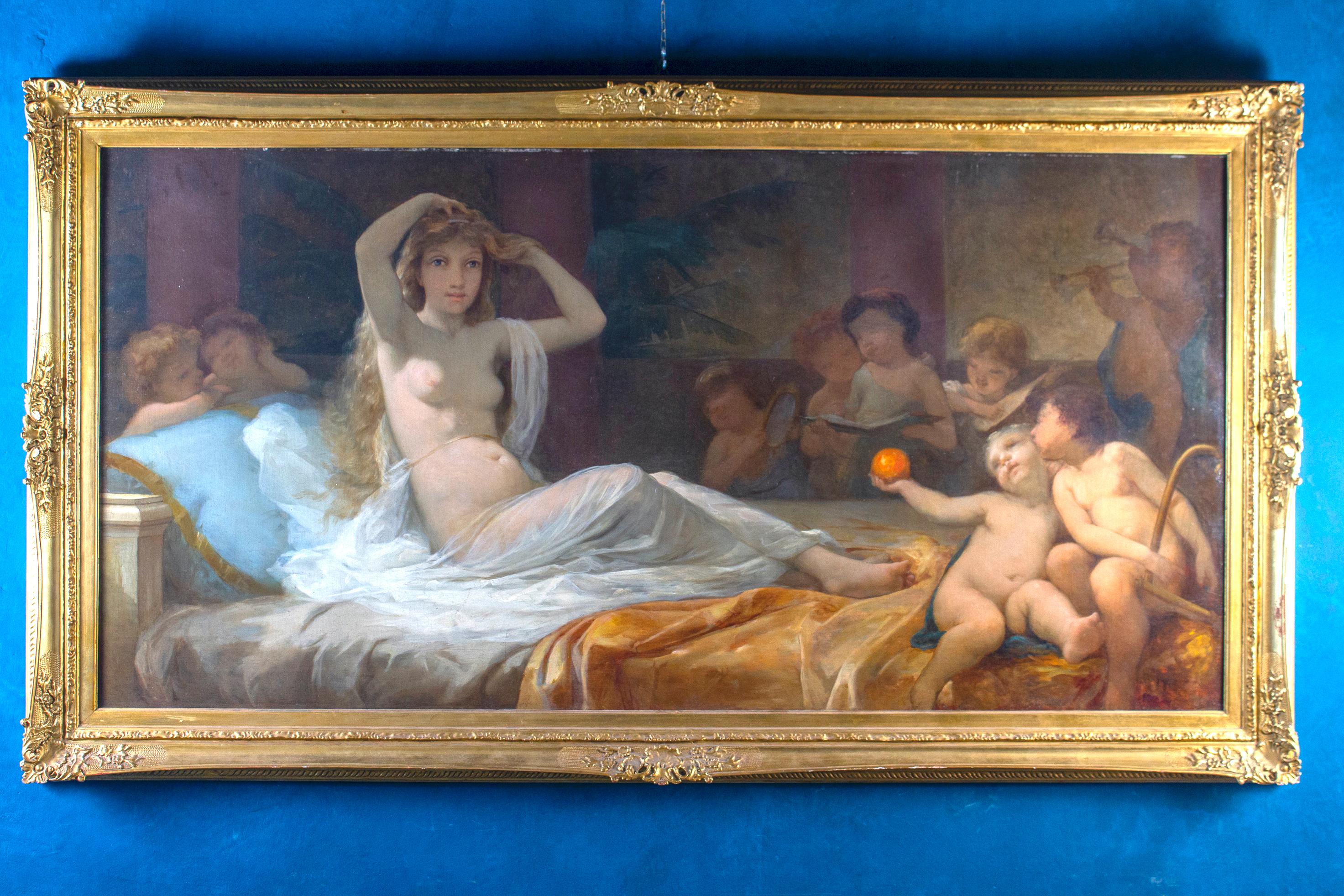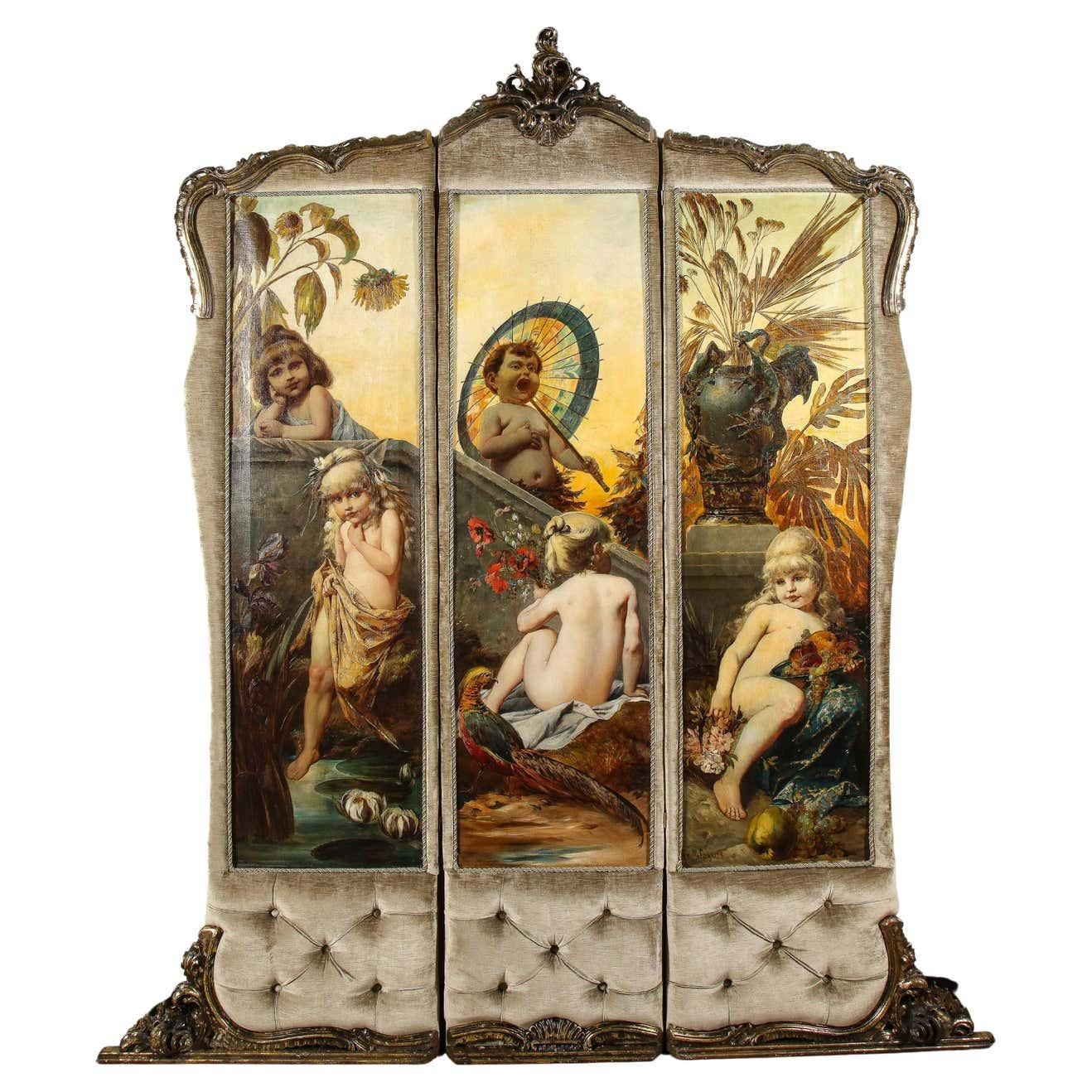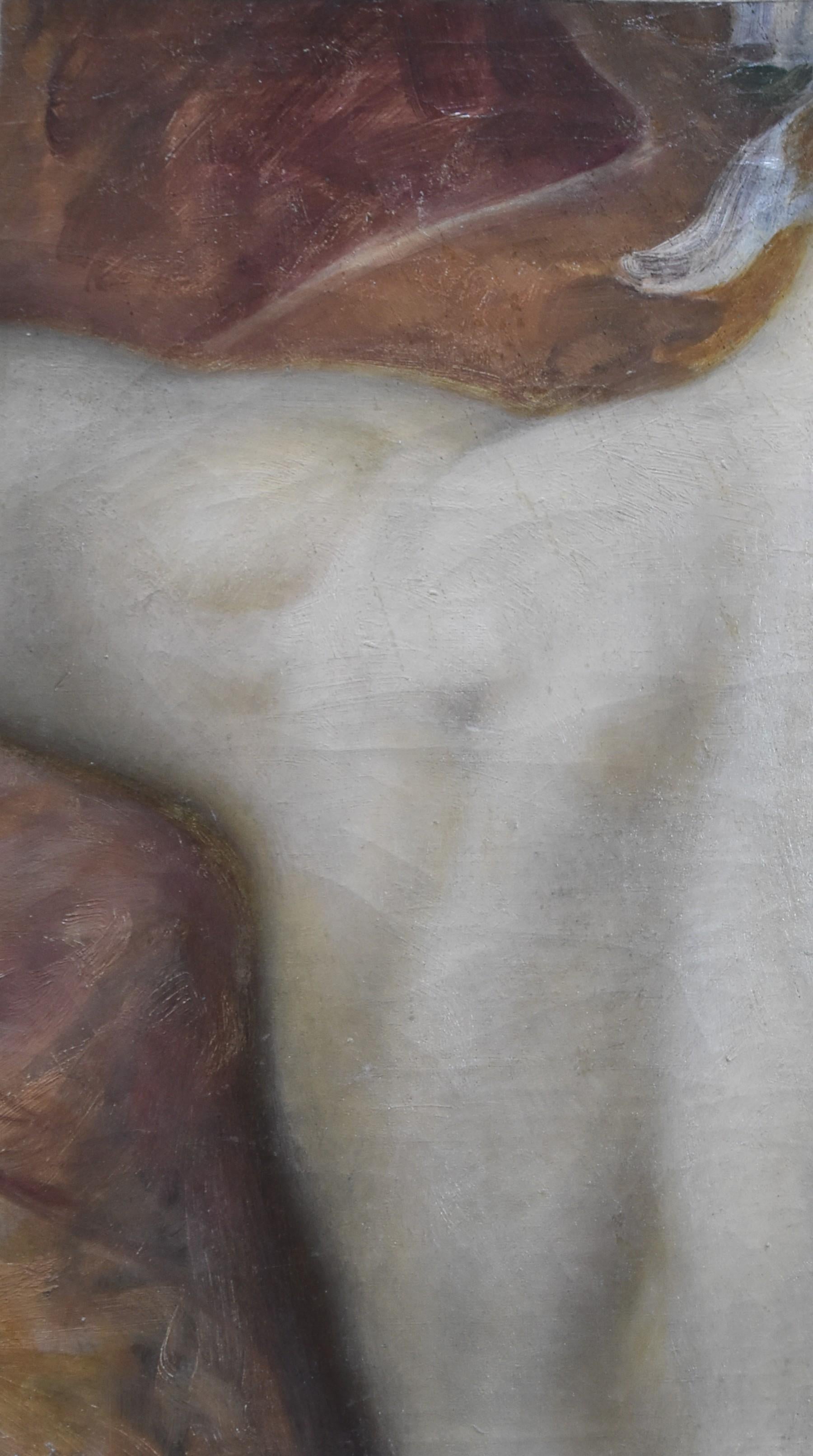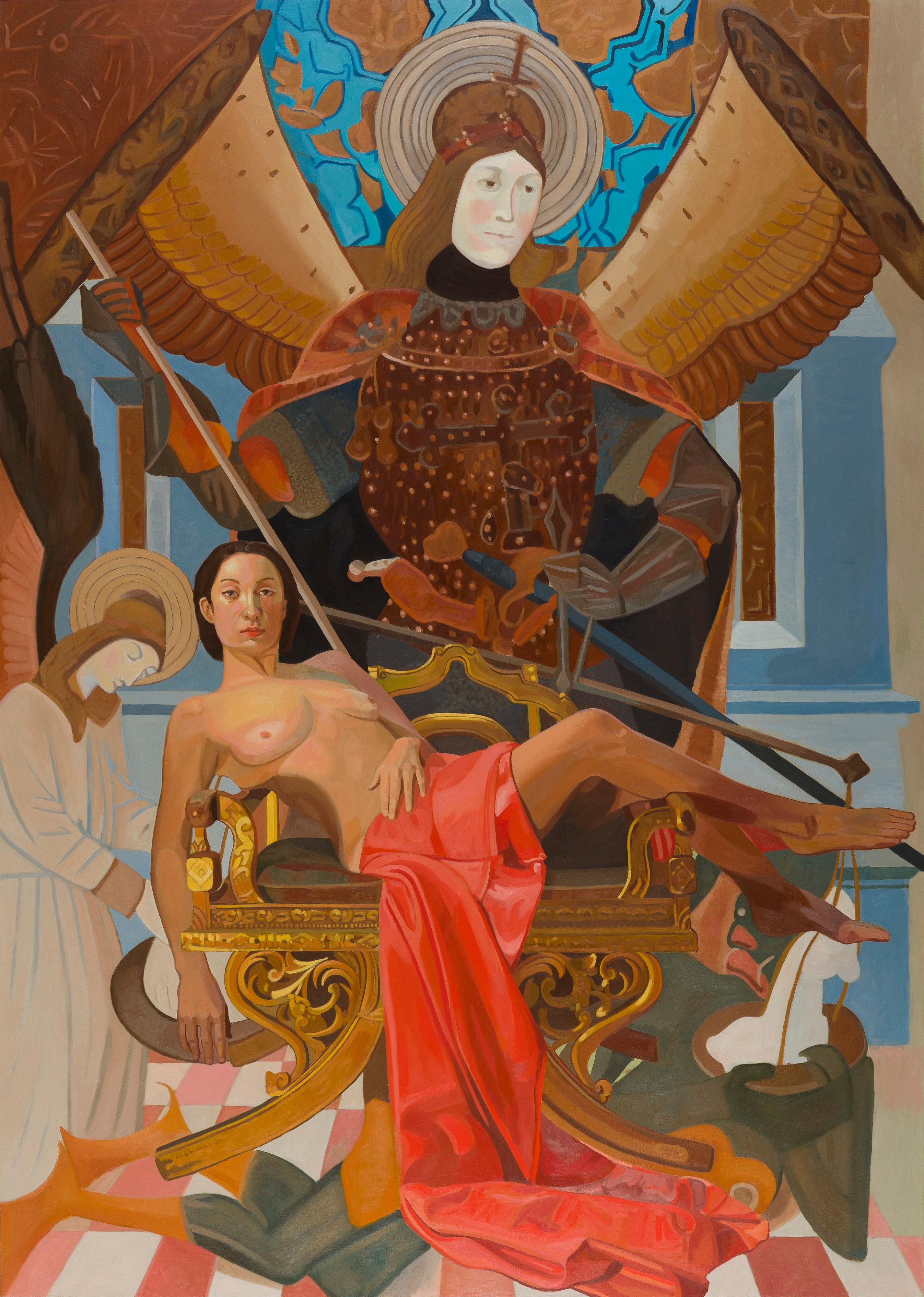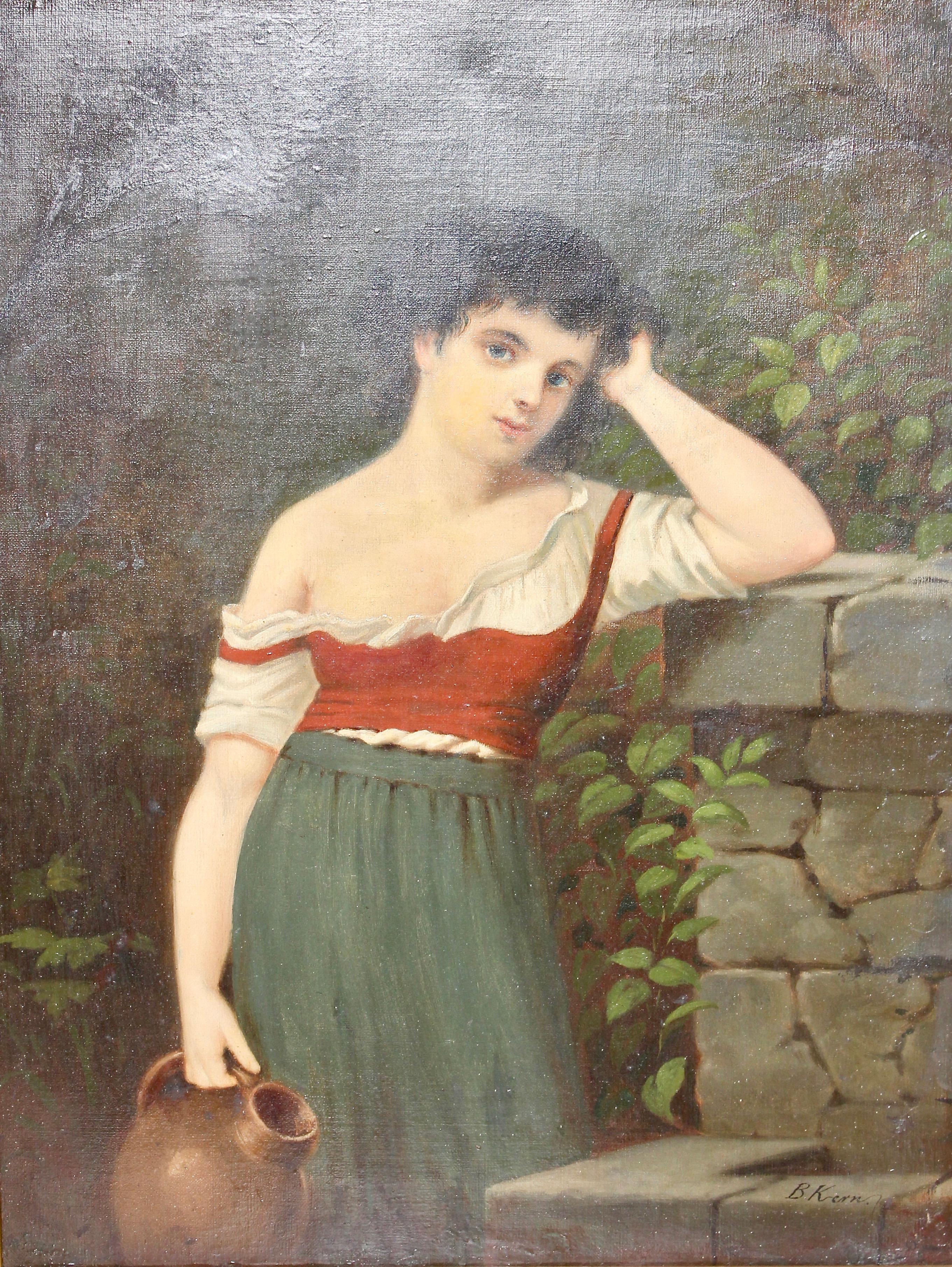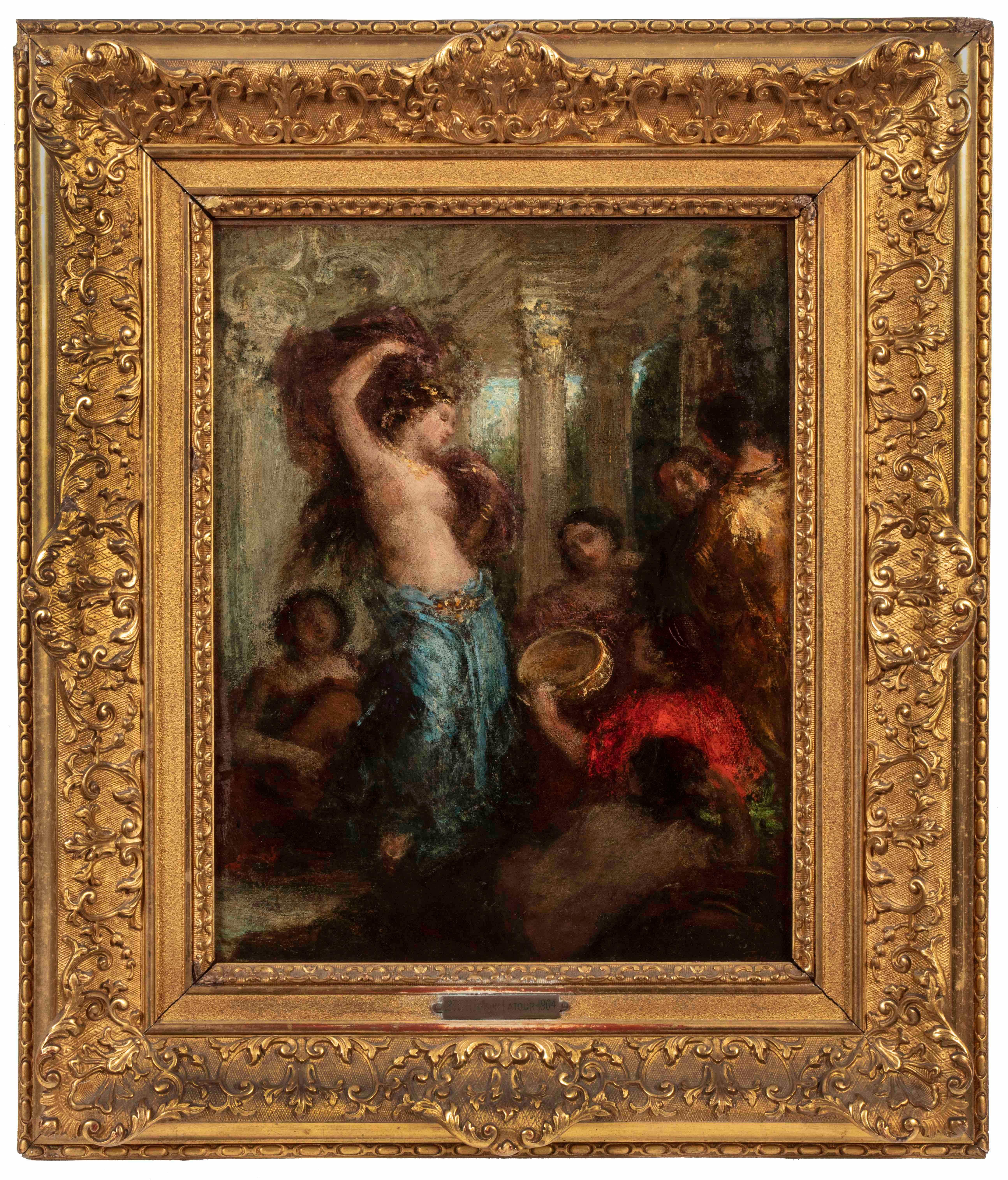Items Similar to Diptych “The Cries of Fire”; “The Voices of the Stream”
Want more images or videos?
Request additional images or videos from the seller
1 of 7
Eugenio AgneniDiptych “The Cries of Fire”; “The Voices of the Stream”1865-1871 c.
1865-1871 c.
About the Item
Artist: Eugenio Agneni
Title: Diptych “The Cries of Fire”; “The Voices of the Stream”, c. 1865-71.
Medium: oil on canvas mounted on wood, cm 128 x 60 each
Signature: Signed at the bottom on the base of the frames
provenance: Marquis Corsi Salviati; Rome, private collection
The two canvases mounted on wooden supports are clearly attributable to Eugenio Agneni (Sutri, 1816 - Rome, 1879), a paradigmatic figure of an Italian painter of the Risorgimento years who combined a successful and continuous international artistic activity with an intense political and military activity, starting from the Roman effervescence following the election of Pius IX to the Mentana expedition and then in the early years of Rome as capital city, a period in which he held various administrative posts. The clarity of attribution of the works derives not only from the large central inscription inserted in the elaborate neo-Gothic scenic layout that encloses the two works in a diptych, but also from the direct kinship that links them to the cycle of frescoes painted between 1865 and 1868 for Marquis Antonio Maria Corsi Salviati in the reception hall of the family villa in Sesto Fiorentino. Agneni resided more or less permanently in the Florentine area between 1863 and 1871 after a phase of European-wide wanderings that began at the end of the Roman republican experience of 1849, in which he was involved to the point of having to hide for some time from July of that year at the home of Marquis Salviati, whom he therefore already knew before his subsequent move to Florence. The need to stay away from Italy, as well as his connections with Mazzinian exiles and evidently also a proven ability to reinvent himself in different cultural spheres allowed Agneni to profitably frequent the artistic scenes of London and Paris, cities in which he lived and worked, obtaining commissions of absolute importance (he decorated several rooms at Buckingham Palace, the Covent Garden Opera and the Louvre), and presenting his works at the Royal Academy in London. Therefore, if we are to keep faith with the remarks of his friend Luigi Calamatta ("you are full of money") and the frequency with which Giuseppe Mazzini asked Agneni to contribute financially to the activities of Giovane Italia or other similar initiatives, the news recorded by Martina Salza that the execution of the works in Sesto Fiorentino was financed by the artist himself as a tribute of friendship towards Marquis Corsi Salviati acquires greater substance. Of the articulated overall iconography, which includes references to the 'Hours', 'Iris', 'Day', 'Night' and the signs of the zodiac, the oil diptych recalls the four frescoes on the longitudinal walls dedicated to the elements and especially 'Fire' and 'Water', thus leaving room to assume that a second diptych dedicated to 'Air' and 'Earth' may have existed. The unfortunate dispersion of numerous and potentially decisive sections of the Guicciardini Corsi Salviati Archive on deposit at the State Archives in Florence unfortunately does not allow for the reconstruction of binding information on the cycle of frescoes, the diptych and the value to be attributed to the two ecphrastic compositions on the canvas and signed by Agneni himself. The fact that both refer to the painter's complex challenge in having to depict the contrasting impulses of natural impetuses seems, in any case, consonant with the particularity of the Corsi Salviati commission, which, as mentioned, was largely financed by the painter himself and, presumably, also had a strong thematic-structural imprint.
There is, for instance, the possibility that the diptych represents a sort of private synthesis of the frescoes, a suggestion suggested by the evident process of erotic emendation brought to the iconography in the monumental version. Note in this sense the presence of the two nude, reclining water lilies on top of the waterfall and at the bottom of the stream (this one replaced by a swallow) in the painting "The Voices of the Stream", as well as the gender transposition of the figure tearing up the earth in "The Cries of Fire", and finally the frequent covering of the breasts by various expedients in both scenes of the frescoes. More solidly tangible is instead the lively expressive ductility displayed here by Agneni, which has re-emerged in these works thanks to a skilful restoration that restores to study a rarely-valued essay on this specific stylistic phase of an artist who, although little known and studied, in fact traversed a substantial portion of the cultural and political arteries of her era with acknowledged charisma. Converging on the two canvases are the intense academic training phase in Rome as well as the shrewd intuition of the connoisseur of the rule who came into contact with even strong linguistic innovations but knew how to render them in a translation suitable for a less up-to-date public. In this superimposition between the Minardian candour of the anatomies and a general expressive voluptuousness that can recall both the more mature phases of French academic romanticism and a certain pre-Raphaelite chromatic verve, Agneni effectively testifies to a linguistic ductility that we recognise in the very lyrics that accompany the diptych: "Cercando le forme dell'acqueo elemento \ Fra vivi colori l'artista ha un concerto \ Finche la mano che s'agita e crea \ Risponde al concerto l'immagin trovò" [from "Le Voci del Torrente"].
Tiziano Antognozzi
condition: generally good condition. The left panel has been re-stained and has a restoration in the lower part due to a cut in the canvas, there are no colour fades.
The other panel is in first cloth.
- Creator:Eugenio Agneni (1816 - 1879, Italian)
- Creation Year:1865-1871 c.
- Dimensions:Height: 50.4 in (128 cm)Width: 23.63 in (60 cm)
- Medium:
- Movement & Style:
- Period:
- Condition:
- Gallery Location:Roma, IT
- Reference Number:1stDibs: LU1926210373102
About the Seller
No Reviews Yet
Vetted Seller
These experienced sellers undergo a comprehensive evaluation by our team of in-house experts.
Established in 1973
1stDibs seller since 2022
- ShippingRetrieving quote...Ships From: Roma, Italy
- Return PolicyThis item cannot be returned.
More From This SellerView All
- Water BearerLocated in Roma, RMoil on canvas 156 x 87 cm signed and dated lower right "Roma MCMXXIV S. Meyer d. S." Exhibitions : Venice Biennale, 1924 The genre that most characterises Sigismondo Meyer's paintin...Category
1920s Art Deco Nude Paintings
MaterialsOil, Canvas
- Savitry (from the Indian poem Mahabharata), 1871Located in Roma, RMArtist: Andrea Gastaldi Title: Savitry (from the Indian poem Mahabharata), 1871 Medium: oil on canvas Signature: signed lower right: “Andrea Gastaldi”. Exhibitions: Promotrice di Bel...Category
1870s Romantic Paintings
MaterialsOil
- GREEK SOLDIER (CORPORAL OF THE IRREGULARS)Located in Roma, RMArtist: Gaetano Gigante Medium: oil on paper laid on canvas Signature: Signed lower right: “G. Gigante” Notes: on the back label with the title Caporale degli irregolari Provenance: ...Category
19th Century Romantic Figurative Paintings
MaterialsOil, Laid Paper
- Female NudeLocated in Roma, RMArtist: Giovanni Zangrando Medium: pastel on paper Bibliography: D’Anza, Giovanni Zangrando (1867-1941), Franco Rosso Editore, 2015 Zangrando was particularly successful as a port...Category
Early 20th Century Realist Nude Paintings
MaterialsPaper, Pastel
- SleepwalkerLocated in Roma, RMArtist: Vincenzo Catalano (attr.) Title: Sleepwalker, 1848 Medium: oil on canvas Exhibition: Exhibition of Fine Arts of the Royal Borbonic Museum of 1848, p. 36, no. 208. Provenance:...Category
1840s Academic Figurative Paintings
MaterialsOil
- The woman with the peacockBy Jules Pierre van BiesbroeckLocated in Roma, RMArtist: Jules Van Biesbroeck Title: Woman with the peacock Medium: Oil on canvas Signature: Signed lower left “J. van Biesbroeck”. Exhibitions: 1905, ...Category
Early 1900s Symbolist Figurative Paintings
MaterialsOil
You May Also Like
- Venus with Putti Oil on Canvas with Gilt-wood FrameLocated in Rome, ITFrench 19' century painting oil on canvas . Young Venus nude figure surrounded by delicious playing putti . Finely carved and gilt-wood frame of the same period . Measurements w...Category
Mid-19th Century Romantic Nude Paintings
MaterialsOil
- Palatial and Opulent Belle Epoque Giltwood & Oil on Canvas Three-Panel ScreenLocated in New York, NYA Palatial and Opulent Belle epoque giltwood & oil on canvas three-panel screen, circa 1890. "Allegory of Youth" Comprising of three exquisite hand-painted triptych oil on canvas panels of cherubs and putti amongst a peacock, all by Ferdinand Wagner II (German, 1847-1927). Each panel depicting different playful and joyous scenes of putti and cherubs. All three-in-one panels within individually carved giltwood and upholstered frames. One panel signed at the lower left: Ferd.Wagner. A truly magnificent and one of a kind piece, perfect for any room in the home. Overall: 101" high 85" wide x 5" deep Very good condition. Ready to place. Ferdinand Wagner II (German, 1847-1927) was the son of Passau Ferdinand Wagner Senior, a teacher at a vocational art school who began training him professionally at a young age. After traveling to Italy in 1867-1868, he continued with his art studies at The Munich Academy of Arts led by Peter Von Cornelius and Julius Schnorr Von Carolsfeld. Wagner II was influenced by the Munich School of master painters and by his art teacher, Karl von Piloty, who had been teaching at the Munich Art Academy since 1856. Piloty’s approach to historical paintings was influenced by the French art academic Paul Delaroche and by the fine artworks by Rubens and the Venetians. After his return to Germany he was commissioned to decorate the former the Tenormayer Wine Tavern in Munich, subsequently he received numerous other commissions as a decorator. Ferdinand Wagner II wall paintings and ceiling frescos...Category
19th Century Romantic Figurative Paintings
MaterialsOil
- J J A Lecomte du Nouÿ (1842-1923) A shoulder and back study, oil paintingBy Jean-Jules-Antoine Lecomte du NouÿLocated in Paris, FRJean-Jules-Antoine Lecomte du Nouÿ (1842-1923) A shoulder and back study, oil study oil on canvas 34 x 19.5 cm In good condition, a few small inpainti...Category
1890s Romantic Nude Paintings
MaterialsOil
- Gilded ChairBy Thomas DarsneyLocated in Boston, MAAn auto-didactic artist, Darsney draws inspiration from a variety of sources, including The Boston School and iconic masters such as Vermeer, Rembrandt, and Degas. These artists’ att...Category
2010s Romantic Nude Paintings
MaterialsOil
- Painting, 19th century, oil on canvas, "Young woman at the well"Located in Berlin, DEPainting, 19th century, oil on canvas, "Young woman at the well" Signed, B. Kern. Dimensions with frame 61cm x 75cmCategory
19th Century Romantic Figurative Paintings
MaterialsCanvas, Oil
- OrientaleBy Henri Fantin-LatourLocated in New York, NYSigned, lower right: Fantin Provenance: Gustave Tempelaere (1840–1904), Paris; possibly by descent to his son: Julien Tempelaere (1876–1961) and with F. & J. Tempelaere, Paris, prob...Category
1890s Romantic Figurative Paintings
MaterialsCanvas, Paper, Oil
